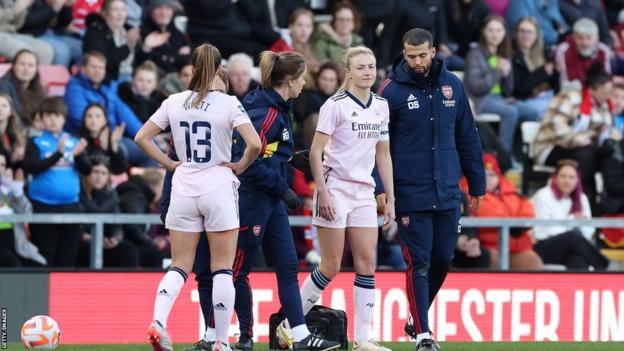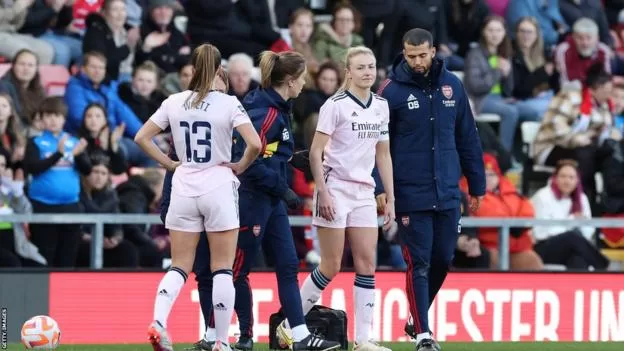
The response to the high number of anterior cruciate ligament injuries suffered by female footballers has been criticised by a committee of MPs.
England stars Leah Williamson and Beth Mead are among those to have injured their ACL recently.
The Women and Equalities Committee (WEC) cited unsuitable boots as a contributing factor.
“The sports science sector’s response to the ACL issue has been disparate and slow,” the WEC said.
Its report calls for better female-specific clothing, footwear and equipment.
“A health issue of similar magnitude affecting elite male footballers would have received a faster, more thorough, and better co-ordinated response,” the report added.
“While female footballers in the UK have enjoyed great success at club and national level, they have done so wearing ill-fitting footwear.
“Few football boots designed for women are available, and those that do exist are rarely stocked or promoted by the UK’s leading high street sports retailers.”
The “Health barriers for girls and women in sport” report was produced by cross-party MPs in line with International Women’s Day, which is on Friday, 8 March.
It called for the Department of Culture, Media and Sport (DCMS) and Department for Education (DfE) to set up a taskforce, increase research and develop a strategy to address the inequalities in women’s health and physiology issues.
Alongside the DCMS and DfE, the report recommends that the taskforce include representatives from UK Sport, women’s health and fitness experts including The Well HQ, sport and exercise research institutes, and the UK divisions of leading sportswear and sporting goods brands.
Chaired by Caroline Nokes MP, the report added that the issue of sportswear and equipment being unsuitable for women is is “indicative of systemic gender inequality in sports and exercise research, which is still overwhelmingly conducted by men, looking at issues affecting men”.
Evidence of girls’ anxieties around PE kit ‘overwhelming’
In the report, the WEC listed research and development of women’s football boots as a priority to avoid injury but also referenced other barriers for female participation including clothing.
At grassroots and school level, the report said that not enough is being done to “reverse alarming downward trends in girls’ enjoyment of PE” and called for more research into the effects of puberty and the menstrual cycle as well as providing more suitable clothing options for lessons.
It also said that the evidence of girls’ anxieties around their PE kit was “overwhelming” and called for more focus on enjoyment of physical activity rather than just participation numbers.
For many teenage girls, period concerns are a significant anxiety trigger and some sports including football have made changes for this reason, with England’s Lionessess now playing in blue shorts instead of white.
But the WEC said that existing programmes “do not go far enough” into addressing the decreasing numbers taking part in girls’ sport.
For older age groups, barriers to sport include childcare, perimenopausal and menopausal symptoms and time pressure from their careers. It also added that there is “still a long road to travel” with regard to maternity pay and leave.
